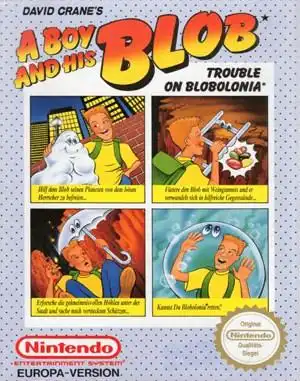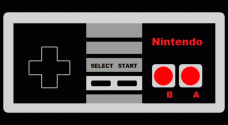Remember that quirky little NES game where you befriended an alien blob who loved jelly beans? If you were gaming in the late '80s, chances are David Crane’s A Boy and His Blob: Trouble on Blobolonia left a peculiar, yet fond, mark on your memory. It wasn't like other games of the era; it was a puzzle-platformer built on a unique friendship and a rather unconventional inventory system.
Let's dive back into the world of Blobolonia and Earth's caverns to rediscover what made this title stand out.
What Was A Boy and His Blob All About?
Released in 1989 for the Nintendo Entertainment System, A Boy and His Blob: Trouble on Blobolonia introduced players to a simple premise: a young boy meets Blobert, an alien blob from the planet Blobolonia, which has been taken over by an evil emperor. Your mission? Help Blobert gather treasure on Earth to buy vitamins needed to defeat the emperor back home.
The twist? The boy can't jump or attack. His only tool is Blobert, who can shapeshift into various objects when fed different flavors of jelly beans. This mechanic was the heart and soul of the game, turning every screen into a potential puzzle.
The Core Gameplay: Jelly Beans and Transformations
Forget power-ups and stomp attacks. Your success in Trouble on Blobolonia hinged entirely on knowing which of the 14 jelly bean flavors would yield the right transformation for the situation.
- Licorice: Ladder
- Apple: Jack
- Cherry: Cherry Bomb
- Strawberry: Bridge
- Root Beer: Ball
- Vanilla: Vertical Bubble (or maybe a Drip?)
- Cola: Cola Bottle (Rocket)
- Orange: Trampoline
- Lime: Key
- Grape: Blowgun (This bean was famously changed during development!)
- Ketchup: Ketchup (Summon Blob back to you)
- Cinnamon: Shield (Bubble)
- Tropical: Bird
- Punch: Hole
Navigating the interconnected screens of Earth's caves and later Blobolonia required you to experiment (and often die) to figure out which bean did what. Need to cross a gap? Strawberry bridge. Reach a high ledge? Licorice ladder. Get past an obstacle? Maybe a cherry bomb or a shield is the answer.
The gameplay was less about reflexes and more about observation, inventory management (you had limited beans!), and trial-and-error. This could be frustrating at times, especially with one-hit deaths and limited lives, but mastering the bean-to-transformation system felt genuinely rewarding.
A Quirky Development Story
Behind this unique concept was legendary game designer David Crane, known for Atari's Pitfall!. Crane envisioned a game where tools were integrated organically into the character. The idea of a shapeshifting friend was partly inspired by the cartoon The Herculoids.
Development was famously rapid, reportedly taking just six weeks! This quick turnaround, combined with the innovative concept, certainly contributed to the game's distinct feel – both in its originality and perhaps some of its rough edges. Fun fact: An early "Grape" bean that created a wall was replaced with the "Ketchup" bean because Nintendo testers kept getting the boy separated from Blobert. The Ketchup bean ("catch up") solved that problem!
Reception and Legacy
Upon release, David Crane’s A Boy and His Blob: Trouble on Blobolonia received mixed reviews. Critics praised its originality, unique premise, and creative use of the blob's transformations. However, some found the execution lacking, citing repetitive environments, limited enemy types, and the often-frustrating trial-and-error gameplay loop.
Despite the mixed reception, the game was commercially successful for Absolute Entertainment and garnered awards, including "Best of Show" at the 1989 CES and a Parents' Choice Award in 1990 for its positive values.
Its legacy endured, perhaps more for its memorable concept than flawless execution. It spawned a Game Boy sequel, The Rescue of Princess Blobette, and most notably, a critically acclaimed re-imaginING for the Wii in 2009 by WayForward, which brought the concept to a new generation with beautiful hand-drawn visuals. The original NES game has also seen re-releases on platforms like the Wii Virtual Console and, more recently, as part of the A Boy and His Blob Retro Collection on modern consoles and PC.
Finding Your Way Back to Blobolonia Today
Feeling nostalgic and want to revisit this peculiar adventure? Or perhaps you missed it the first time around and are curious?
- Retro Collection: The easiest way is the recent A Boy and His Blob Retro Collection, which includes the original NES game and the Game Boy sequel on modern platforms.
- Virtual Console: If you have older Nintendo hardware like the Wii, the original was available on its Virtual Console service.
- Emulation: For PC, NES emulators paired with the game's ROM (ensure you own a physical copy or check legal grey areas like Archive.org's lending library) offer another path back to Blobolonia.
Whichever way you choose, be prepared for a game that's charmingly weird, sometimes frustratingly difficult, but undeniably unique.
FAQ
What kind of game is David Crane’s A Boy and His Blob: Trouble on Blobolonia?
It's primarily a puzzle-platformer where you use a shapeshifting blob, controlled by feeding it different jelly beans, to overcome obstacles.
Who designed A Boy and His Blob?
The game was designed by David Crane, famous for creating Pitfall!.
How many jelly bean types are in the game?
There are 14 different flavors of jelly beans, each transforming Blobert into a different object.
Can I play the original NES A Boy and His Blob today?
Yes, the original game has been re-released on platforms like the Wii Virtual Console and is included in the recent A Boy and His Blob Retro Collection available on modern consoles and PC.
David Crane’s A Boy and His Blob: Trouble on Blobolonia remains a fascinating footnote in NES history – a testament to creative design and the era's willingness to embrace unconventional ideas. It's a game that truly makes you think outside the box... or perhaps, outside the jelly bean bag. Give it a try if you're looking for a retro challenge unlike any other!


